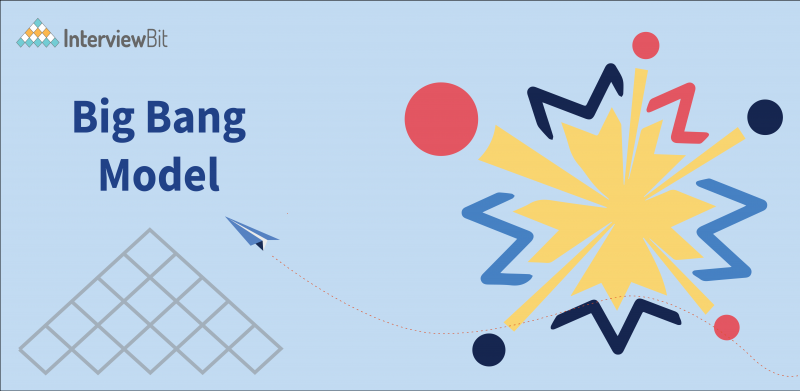Introduction
In this blog, we will discuss one of the SDLC Model’s but before that let’s see what does SDLC model means.
From the initial feasibility study to the maintenance of the completed application, the Software Development Life Cycle (SDLC) is a conceptual model used in project management that outlines the steps included in an information system development project. Various software development life cycle models outline and design the steps that must be performed during the software development phase. “Software Development Process Models” is another name for these models. To assure success in the step of software development, each process model follows a number of phases specific to its nature. One such model is the Big Bang Model, this complete blog will be about what is big bang model, its design and application, when to use this model, and what are its advantages and disadvantages.
What is the Big Bang Model?
The Big Bang model is a start-from-scratch SDLC model. It’s the simplest SDLC (Software Development Life Cycle) model because it doesn’t require any planning. The big bang model was named after the “Great Big Bang,” which resulted in the formation of galaxies, stars, planets, and other objects. To produce a product, this SDLC model combines time, effort, and resources. The product is gradually constructed as the customer’s requirements come in, although the final product may not meet those requirements. This model requires rigorous coding and an ample amount of funds for execution.
The main goal of this model is start coding right away, without going through any specific structure and deliver the product to customer. Without knowing the end result, the day to day development gets started on the basis of some initial requirements. The client interacts with the development team to monitor the result of the development performed. If the end result is as expected then the product is approved otherwise some other approach is searched and worked upon to get the expected product.
Confused about your next job?
This paradigm is typically used for short projects with small development teams which means this model can be developed by one or two developers working together. The reason why the model is not suitable for large projects is the high risk involved in the model. Even the customer is unsure of what he wants, and the criteria are implemented without much thought. So when the requirements are not cleared for the end product then it’s advisable to use this model for short and simple projects. Below mentioned points are some features of this model:
- A quick summary of the prototype is provided.
- Little work is required, and the concept of implementation is simple.
- A well-documented requirement specification is not required.
- Allows for the integration of newer technologies in order to observe changes and adaptation.

Big Bang Model – Design and Application
The Big Bang model entails concentrating all available resources and tools in software development and coding, with little or no planning ahead of time. The requirements are understood and implemented as they arise in this model. Any required changes and/or functionality additions under the created system may or may not necessitate a complete programme rewrite.
This software development paradigm is suited for small projects requiring one or two developers to collaborate. This methodology can also be used to build academic or practise projects. It’s a great approach for a product where the needs aren’t clear and the delivery date isn’t set in stone.
The Big Bang SDLC methodology emphasises the testing of each module as soon as it is ready to be integrated. These modules are then combined and tested by running the full product to see if there are any bugs in the system. The following elements of the Big Bang model can be phased out:
- Modules are integrated in this development methodology because all of the individual modules are completely built and not integrated separately or individually.
- Each module is examined separately for faults and flaws.
- If a module contains a flaw or error, the module is deconstructed and the fundamental cause of the problem is determined.
When to Use the Big Bang Model?
As discussed above Big Bang Model is used for small and simple projects in which a small team is working on the project, the customer’s requirements are not precise and change frequently, or the project is a dummy/side project. This strategy is regarded the worst SDLC model since it lacks sufficient planning and is unsuitable for major projects. It is only recommended to use the Big Bang model in the following situations:
- Creating a project for educational or experimental objectives.
- Newer requirements that come along in middle of development must be implemented right away.
- There is no clarification about the user’s expectations.
- There are no hard and fast rules on when a product should be released or when it should be delivered.
- Adapting requirements based on the present state of development of the product.
Advantages of Big Bang Model
Now lets walk through some of the advantages of Big Bang Model. Below mentioned points gives a glimpse for the benefits of this model:
- It demands little forethought. There is no need for extensive study or planning; simply begin coding. As a result, no planning, analysis, documentation, or high-level design are required.
- It’s a straightforward model that’s simple to implement. It is a very simple concept to adopt because no Software development life cycle process steps are required.
- It is a cost-effective solution. It takes fewer resources, developers, and management costs to use this paradigm in software development, making it cost-effective.
- It necessitates the use of fewer resources. This paradigm is ideal for small software development projects in which one to two developers collaborate to create a product or as a dummy project.
- It’s appropriate for modest jobs. Because there is no requirement for a workforce and no SDLC process phases, it can only manage minor projects.
- There is no time constraint for the project, making it very flexible for developers: There is no deployment date for the software product, which relieves developers of the pressure to produce the product.
- It generates high-quality developers, or full-stack developers: For newbies or students, this approach aids in the development of software coding skills in many technologies.
- Managing it is simple. To begin the project, no incoming processes are necessary. As a result, this device is simple to operate. It’s ideal for low-risk, small-scale applications.
Disadvantages of Big Bang Model
Under this heading we will see through some disadvantages of this model and those are:
- For long-term projects, it is the worst model. Multiple processes are required for a long or large project, such as service level agreements, planning, preparation, analysis, testing, and execution, which the Big Bang model lacks. As a result, for a large project, it is the worst model.
- It is not appropriate for large or complicated projects. We can’t utilise it to develop a large or complex project because it’s a high-risk model.
- It is a low-cost model. Because the product was not used in the worldwide market, this model gives a lower return on investment (ROI).
- It’s an Extremely Dangerous model. This methodology is dangerous since it requires less planning and does not require following the SDLC process phases during software development.
- It is inherently unreliable. The presence of a software product may or may not be used for business purposes, and the product’s longevity is limited, therefore it is inherently uncertain.
Conclusion
In this blog, we focused on one of the SDLC Big Bang models in particular. This is how we create a short project for school or university. Developing a large project as a high-risk paradigm is not appropriate for the software industry. To produce a software product, the Agile approach is now used by the whole software industry. This blog also discusses the pros and cons of the Big Bang model, as well as the its design and application. It’s too simple, but it’s risky for huge projects with a lot of moving parts, and it would necessitate the involvement of experts who are well-versed in the technology.
FAQs
What is big bang model example?
“HACKATHON” refers to a platform, codefest, or event in which developers or students compete to create a working piece of software in a short amount of time. This Hackathon is one of the best example that comes under the category of Big Bang Model.
What are the key stages of Big Bang model?
Key stages of the model are:
- Start coding at the very moment when few requirements are ready
- Work in modules and later integrate them
- After development each module should be tested separately
- While testing if some bug is reported then that particular module is separated from rest and cause of the error is identified.
- Then fix those errors and connect with the client to get feedback if the product is same as desired by them then they get a headsup, if not then team has to work upon it again taking some other approach.




